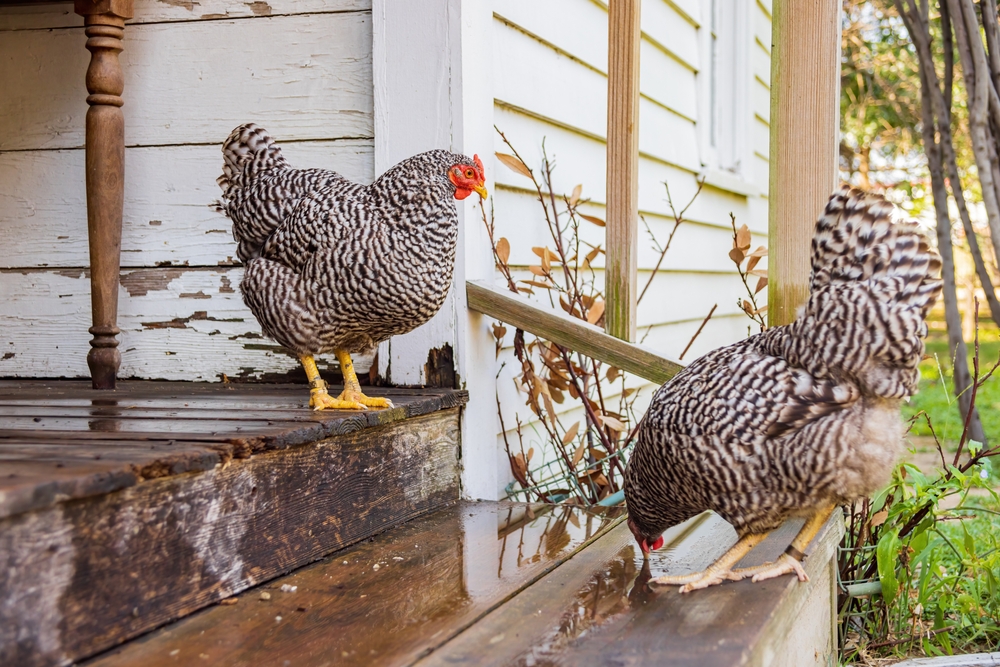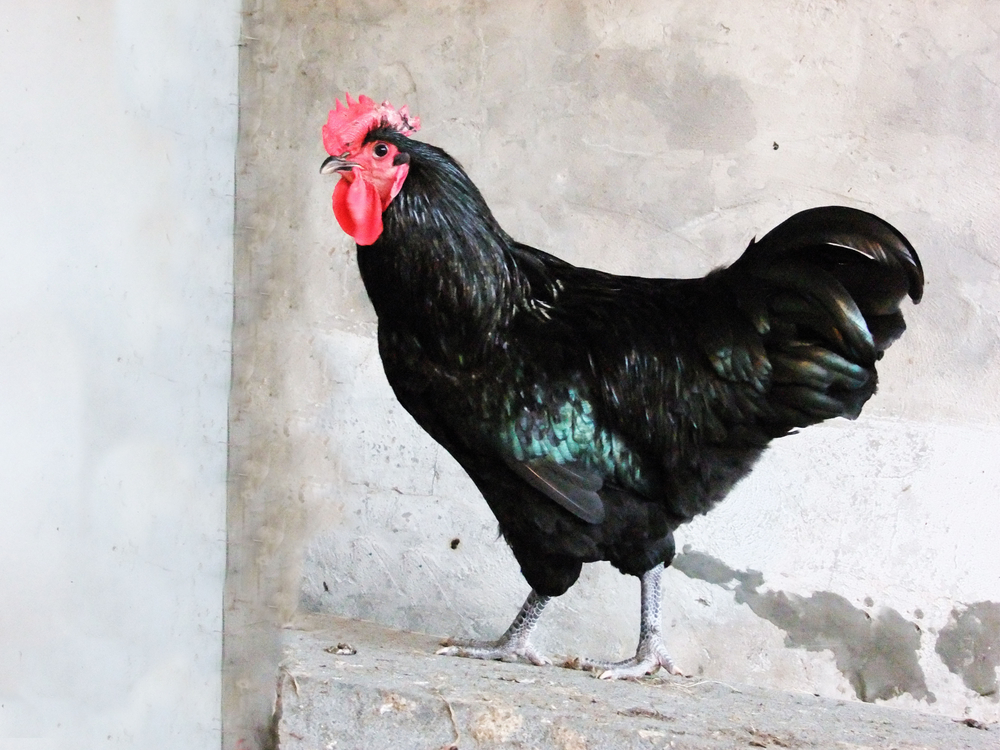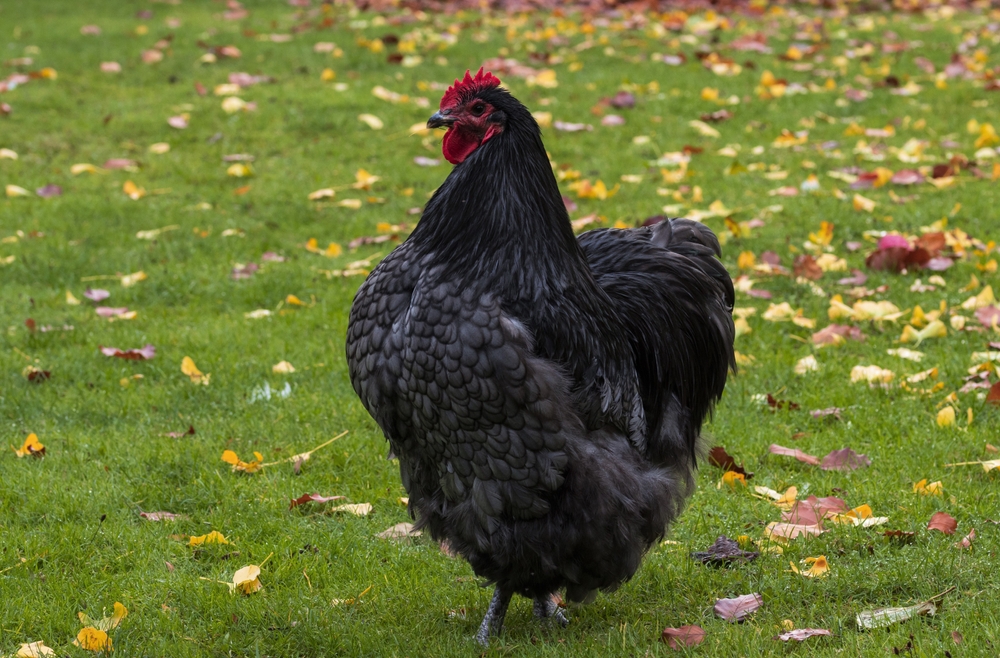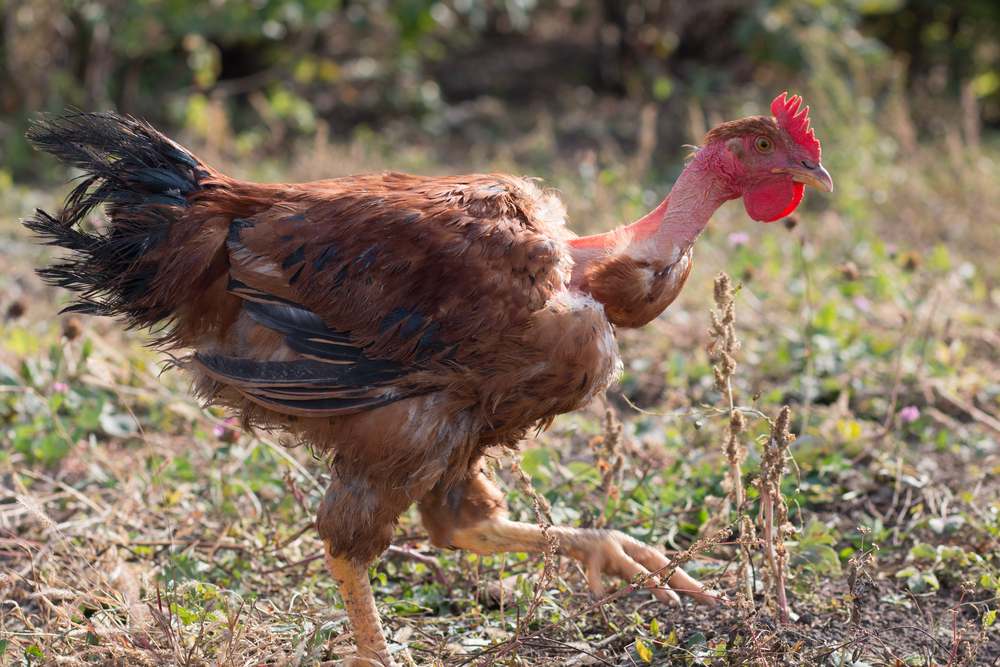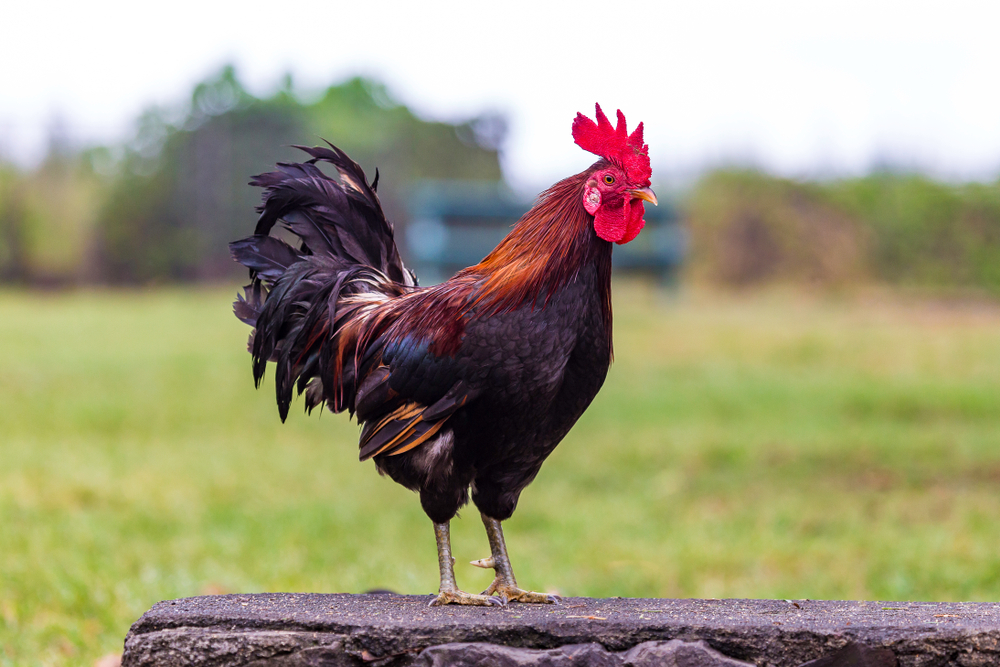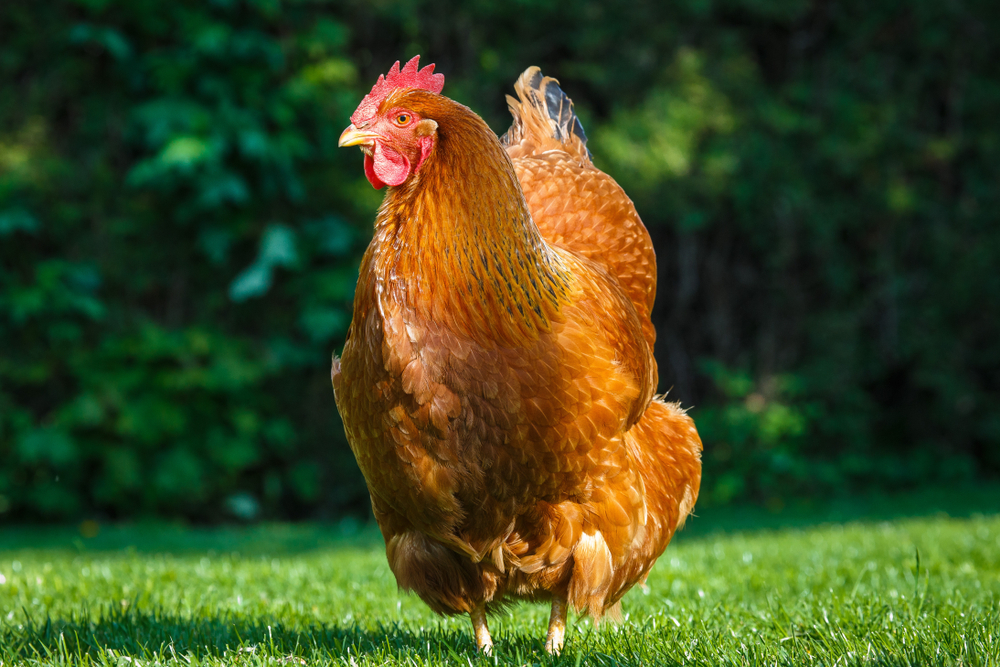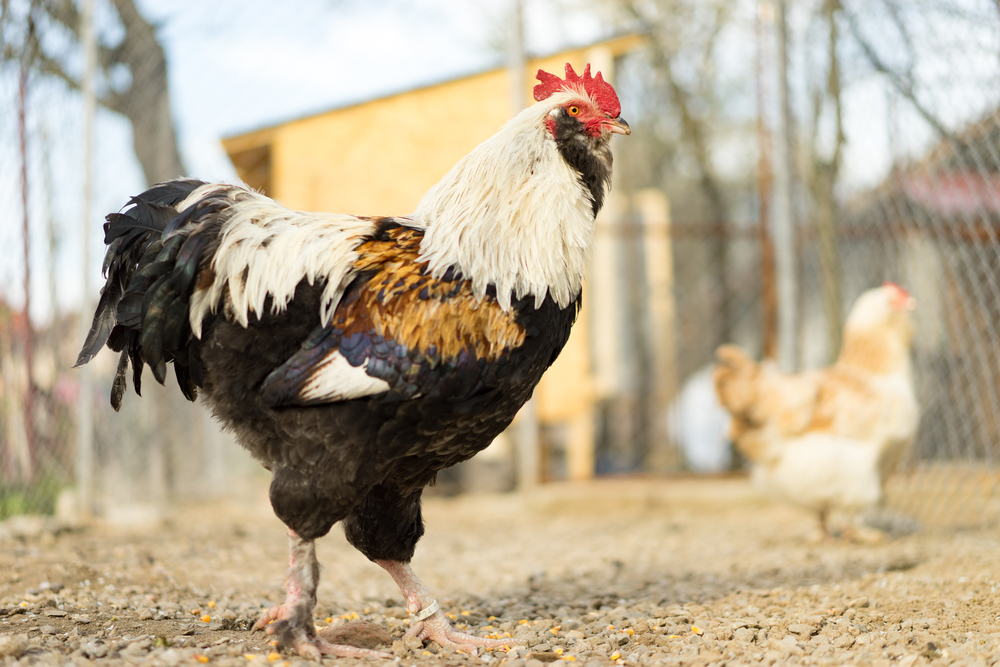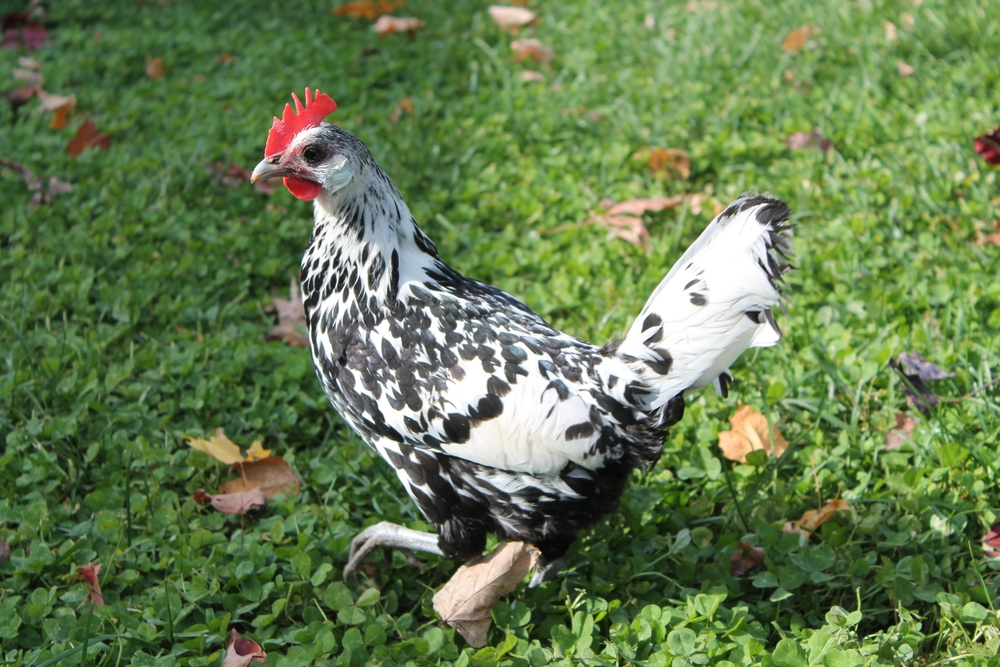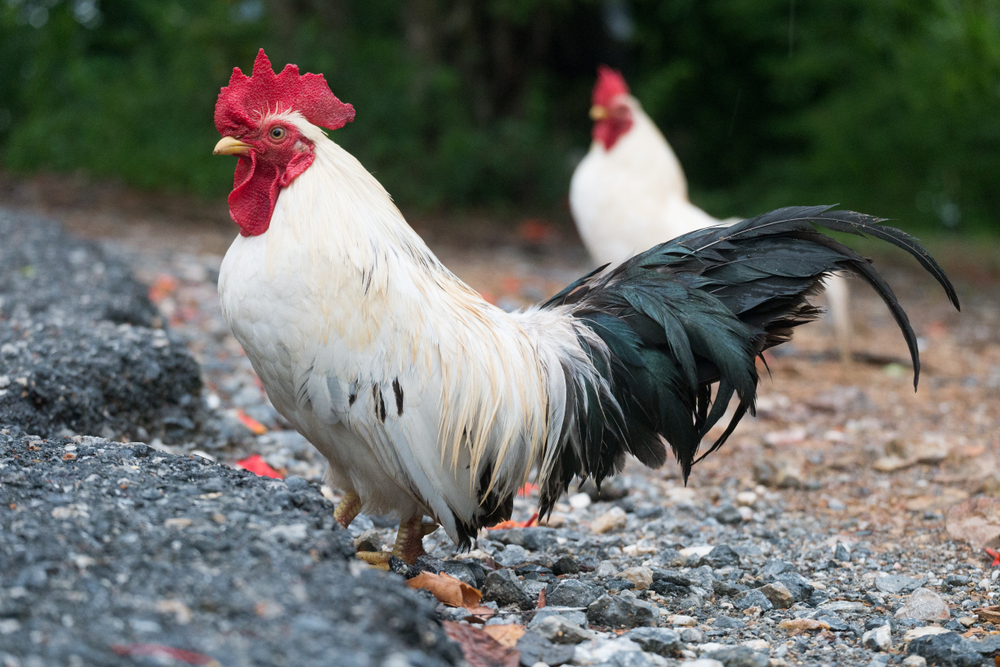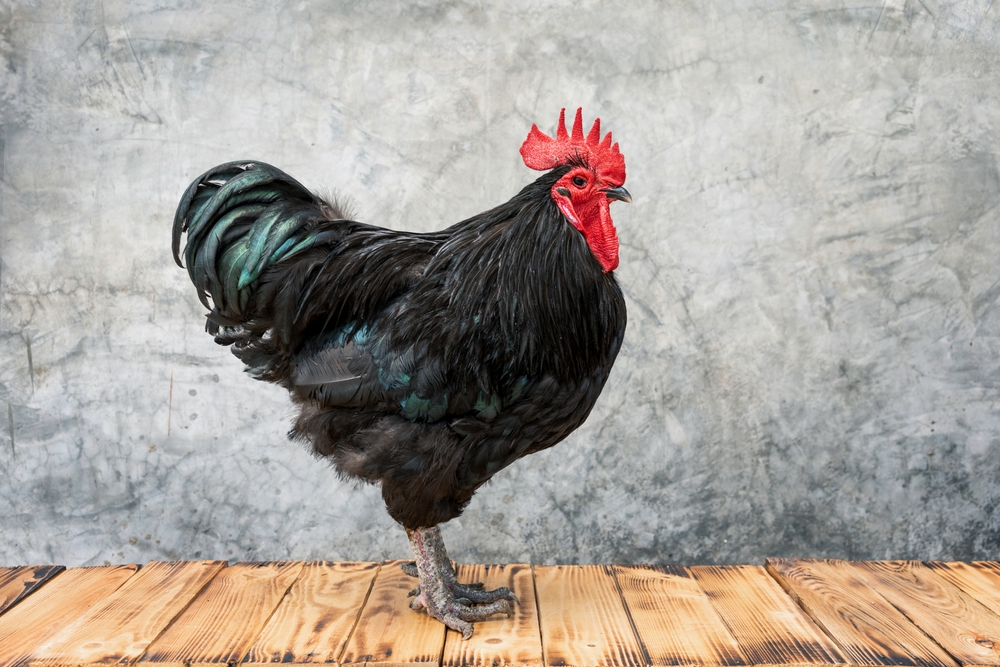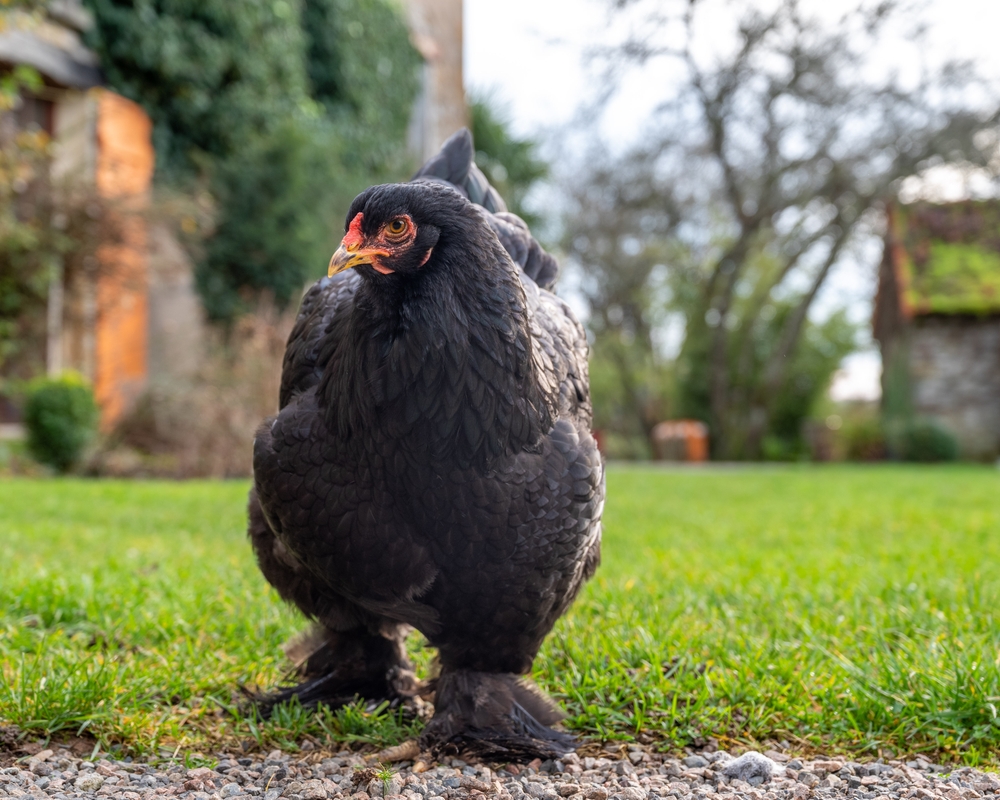The closest related breed to the Plymouth Rock is the Dominique, an older American breed that also features barred plumage. While similar in appearance, Dominiques have a rose comb and slightly lighter body build, whereas Plymouth Rocks have a single comb and a heavier dual-purpose frame.
About
The Plymouth Rock is a classic American dual-purpose chicken breed developed in the United States in the mid-19th century. First exhibited in 1849 and standardized in the 1870s, it quickly became one of the most popular farmyard breeds due to its hardiness, productivity, and calm disposition.
The most iconic variety is the Barred Plymouth Rock, with alternating black and white bands on each feather creating a striking striped effect. Other recognized color varieties include white, buff, silver-penciled, partridge, blue, and Columbian. They have a broad, deep body, yellow legs, and a single upright comb.
Plymouth Rocks are medium to large in size, with roosters weighing 3.4–3.9 kg (7.5–8.5 lbs) and hens around 2.9–3.4 kg (6.5–7.5 lbs). They are steady layers, producing 200–250 large brown eggs per year, and their calm, friendly temperament makes them excellent for backyard flocks and family farms.
They are also valued as a meat bird, with well-fleshed carcasses and good table quality. Their ability to thrive in both free-range and confined systems, along with tolerance for various climates, contributed to their widespread adoption in the early 20th century.
Plymouth Rocks are alert but not flighty, integrating well with mixed flocks. Their even temperament and adaptability have kept them popular among heritage breed enthusiasts, even as commercial hybrids have replaced them in industrial egg production.
The Plymouth Rock’s scientific classification is Gallus gallus domesticus, and it belongs to the family Phasianidae.
Physical Characteristics
Plumage:
Plymouth Rocks have close-fitting, moderately loose feathers that give them a full yet smooth outline. The most well-known variety is Barred, featuring alternating black and white stripes of equal width across each feather, creating a crisp, uniform pattern. Other recognized varieties include White, Buff, Silver Penciled, Partridge, Columbian, and Blue.
Head and Comb:
The head is medium-sized with a single, upright comb of 5 evenly spaced points. Comb, wattles, and earlobes are bright red, while the beak is short, stout, and yellow. Eyes are reddish bay, providing sharp vision for foraging.
Body:
The body is broad, deep, and long, with a full breast and well-rounded form. The back is broad and slopes gently toward the tail, giving the breed a balanced, sturdy appearance suited to its dual-purpose role.
Legs and Feet:
The legs are strong, clean (feather-free), and yellow in color, with four well-spaced toes per foot. The shanks are moderately long, giving good ground clearance for foraging.
Tail:
The tail is medium length and moderately spread, with roosters displaying well-arched sickle feathers. Hens have a shorter, more compact tail.
Size:
-
Male Weight: 9.5 lbs (4.3 kg)
-
Female Weight: 7.5 lbs (3.4 kg)
-
Bantam Variety: Males around 36 oz (1.02 kg), females around 32 oz (0.91 kg)
Sexual Dimorphism:
Males are larger with longer, more curved tail feathers, pointed hackles and saddle feathers, and a more upright stance. Females are rounder in body shape and have more subdued feather sheen.
Plymouth Rocks’ distinctive barred plumage (in the most common variety), sturdy build, and balanced dual-purpose frame make them one of the most recognizable and dependable heritage chicken breeds.
Reproduction
Mating Behavior:
Plymouth Rocks are docile and easygoing, which makes them simple to manage in breeding flocks. Roosters are generally steady and not overly aggressive toward hens, making them suitable for mixed-breed flocks. A typical breeding ratio is 1 rooster for every 8–10 hens to ensure good fertility without overbreeding.
Breeding Season:
They can breed year-round in mild climates, though fertility and hatching rates are highest in spring and summer. Their cold-hardiness allows them to maintain decent fertility in cooler months compared to many lighter breeds.
Egg Laying:
Plymouth Rocks are dependable layers of brown eggs.
-
Annual Output: 200 to 250 large eggs per year.
-
Egg Color: Light brown to medium brown.
-
Egg Size: Large.
Egg production remains relatively consistent over several years, making them a long-term flock investment.
Broodiness and Incubation:
-
Plymouth Rock hens are occasionally broody and are considered good mothers when they set.
-
Broody hens maintain their nests well, turning eggs and keeping steady warmth.
-
Incubation Period: About 21 days.
Chicks:
-
Appearance at Hatch: Fluffy and generally barred or down-colored to match the variety; barred chicks show dark down with light head spots.
-
Self-Sufficiency: Active within hours, quick to begin eating and drinking.
-
Growth Rate: Moderate to fast, with good meat development while retaining laying ability.
Maturity:
Hens begin laying at around 5 to 6 months, while roosters reach full breeding maturity around the same age.
The Plymouth Rock’s high fertility, dependable laying, and solid maternal instincts make it a well-rounded choice for small farms and backyard breeders.
Lifespan
Plymouth Rock – Lifespan
Lifespan in the Farm/Backyard Setting:
Plymouth Rocks are hardy, long-lived chickens that typically live 6 to 8 years in well-managed flocks. They remain productive layers for the first 3 to 4 years, after which egg production gradually declines, though they can still lay sporadically in later years.
Lifespan in Optimal Conditions:
With excellent nutrition, secure housing, predator protection, and regular health care, Plymouth Rocks can exceed their average lifespan.
-
Average Maximum Lifespan: 8 to 10 years
-
Exceptional cases: 10–12 years, especially in non-production or pet settings.
Threats to Longevity:
-
Predation: Vulnerable to foxes, raccoons, hawks, owls, and dogs when free-ranging.
-
Reproductive Strain: High early productivity can lead to reproductive issues such as egg binding or internal laying later in life.
-
Parasites and Disease: Susceptible to mites, lice, worms, and respiratory illnesses if housing is not clean and well-ventilated.
-
Obesity: If overfed on scratch grains without sufficient exercise, they may gain excess weight, reducing lifespan.
Adaptations for Longevity:
Plymouth Rocks are cold-hardy, adaptable, and resilient, tolerating a wide range of climates and foraging conditions. Their balanced temperament and strong immune systems help them thrive in both free-range and confined environments.
Eating Habits
Diet:
Plymouth Rocks are omnivorous foragers, thriving on a balanced mix of commercial poultry feed and naturally sourced foods.
-
Primary Feed: High-quality layer pellets or mash with 16–18% protein, plus added calcium for strong eggshells.
-
Foraged Foods: Insects, worms, snails, seeds, grasses, weeds, and other small invertebrates.
-
Treats and Supplements: Whole grains (corn, oats, wheat), leafy greens, vegetable scraps, grit for digestion, and oyster shell or limestone for calcium.
Feeding Behavior:
-
Calm and steady feeders, Plymouth Rocks do well in both free-range and confined systems.
-
They are efficient foragers, supplementing their diet with natural protein sources when allowed to roam.
-
Roosters often tidbit to call hens over to food sources.
Foraging Times:
-
Most active in morning and late afternoon, resting or dust-bathing during the warmest part of the day.
-
In cooler climates, they may remain active foraging for longer hours.
Adaptations for Feeding:
-
Strong, broad beaks for cracking seeds and dislodging insects from the ground.
-
Balanced body weight and good walking endurance allow them to forage effectively over varied terrain.
-
Hardy digestive systems that can utilize a diverse diet without losing productivity.
Captive Diet Management:
-
A balanced feed should make up the majority of their diet to sustain high egg production.
-
Overfeeding scratch grains can lead to weight gain and reduced laying efficiency.
Plymouth Rocks’ efficient foraging ability, adaptability to different diets, and calm feeding habits make them ideal for both backyard keepers and small-scale production flocks.
Uniqueness
Iconic Barred Pattern:
The most recognizable Plymouth Rock variety, the Barred Plymouth Rock, features evenly spaced black and white stripes across each feather, creating a striking and uniform pattern that is both attractive and practical for camouflage in free-range environments.
True Dual-Purpose Heritage:
Developed in the United States in the mid-1800s, Plymouth Rocks were bred for both high egg production and quality meat, making them one of the earliest American dual-purpose success stories.
Cold-Hardy and Adaptable:
With dense feathering, a balanced body size, and a calm temperament, Plymouth Rocks thrive in a wide range of climates, continuing to lay well through cold winters.
Long-Term Productivity:
While not as high-yielding as modern hybrids in the short term, they maintain consistent laying over more years, making them a practical choice for small farms and homesteads.
Docile and Friendly Temperament:
Plymouth Rocks are gentle, curious, and easy to handle, making them an excellent choice for families and first-time chicken keepers. They integrate well into mixed flocks without being overly dominant.
Multiple Varieties:
In addition to the classic Barred, the breed is recognized in several other varieties, including White, Buff, Partridge, Silver Penciled, Columbian, and Blue, offering both utility and ornamental value.
The Plymouth Rock’s blend of beauty, temperament, adaptability, and dual-purpose performance has made it one of the most enduring and beloved American chicken breeds.
Be the First to Share Photos of This Species.
FAQ’s
1. What is the closest species to the Plymouth Rock?
2. How does the Plymouth Rock compare to other chickens?
The Plymouth Rock stands out from many other breeds by:
-
Offering a true balance between meat and egg production, unlike modern hybrids that favor one over the other.
-
Having dense, cold-hardy feathering that allows year-round laying in a variety of climates.
-
Being calm and friendly, making them easier to handle than flightier breeds like Leghorns.
-
Maintaining steady productivity over multiple years, outlasting the short laying cycles of commercial hybrids.
-
Coming in multiple color varieties, with the Barred pattern being iconic in American poultry history.
3. What national parks provide the best chances to see a Plymouth Rock?
As a domesticated heritage breed, Plymouth Rocks are not found in the wild. However, they can be seen at heritage farms, agricultural museums, and rare breed conservation programs such as:
-
Billings Farm & Museum (Vermont, USA)
-
Old Sturbridge Village (Massachusetts, USA)
-
Colonial Williamsburg Rare Breeds Program (Virginia, USA)
-
Shelburne Farms (Vermont, USA)
-
Sovereign Hill (Victoria, Australia)
These locations keep Plymouth Rocks as part of living history exhibits and heritage livestock displays.



































































